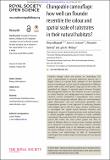| dc.contributor.author | Barbosa, Alexandra | |
| dc.contributor.author | Maethger, Lydia M. | |
| dc.contributor.author | Akkaynak Yellin, Derya | |
| dc.contributor.author | Siemann, Liese A. | |
| dc.date.accessioned | 2017-06-20T15:27:06Z | |
| dc.date.available | 2017-06-20T15:27:06Z | |
| dc.date.issued | 2017-02 | |
| dc.date.submitted | 2016-10 | |
| dc.identifier.issn | 2054-5703 | |
| dc.identifier.uri | http://hdl.handle.net/1721.1/110056 | |
| dc.description.abstract | Flounder change colour and pattern for camouflage. We used a spectrometer to measure reflectance spectra and a digital camera to capture body patterns of two flounder species camouflaged on four natural backgrounds of different spatial scale (sand, small gravel, large gravel and rocks). We quantified the degree of spectral match between flounder and background relative to the situation of perfect camouflage in which flounder and background were assumed to have identical spectral distribution. Computations were carried out for three biologically relevant observers: monochromatic squid, dichromatic crab and trichromatic guitarfish. Our computations present a new approach to analysing datasets with multiple spectra that have large variance. Furthermore, to investigate the spatial match between flounder and background, images of flounder patterns were analysed using a custom program originally developed to study cuttlefish camouflage. Our results show that all flounder and background spectra fall within the same colour gamut and that, in terms of different observer visual systems, flounder matched most substrates in luminance and colour contrast. Flounder matched the spatial scales of all substrates except for rocks. We discuss findings in terms of flounder biology; furthermore, we discuss our methodology in light of hyperspectral technologies that combine high-resolution spectral and spatial imaging. | en_US |
| dc.description.sponsorship | United States. National Institutes of Health (NIH-NEI EY021473) | en_US |
| dc.language.iso | en_US | |
| dc.publisher | Royal Society | en_US |
| dc.relation.isversionof | http://dx.doi.org/10.1098/rsos.160824 | en_US |
| dc.rights | Creative Commons Attribution 4.0 International License | en_US |
| dc.rights.uri | http://creativecommons.org/licenses/by/4.0/ | en_US |
| dc.source | The Royal Society | en_US |
| dc.title | Changeable camouflage: how well can flounder resemble the colour and spatial scale of substrates in their natural habitats? | en_US |
| dc.type | Article | en_US |
| dc.identifier.citation | Akkaynak, Derya; Siemann, Liese A.; Barbosa, Alexandra and Mäthger, Lydia M. “Changeable Camouflage: How Well Can Flounder Resemble the Colour and Spatial Scale of Substrates in Their Natural Habitats?” Royal Society Open Science 4, no. 3 (March 2017): 160824 © 2017 The Authors | en_US |
| dc.contributor.department | Massachusetts Institute of Technology. Department of Mechanical Engineering | en_US |
| dc.contributor.department | Woods Hole Oceanographic Institution | en_US |
| dc.contributor.mitauthor | Akkaynak Yellin, Derya | |
| dc.contributor.mitauthor | Siemann, Liese A. | |
| dc.relation.journal | Royal Society Open Science | en_US |
| dc.eprint.version | Final published version | en_US |
| dc.type.uri | http://purl.org/eprint/type/JournalArticle | en_US |
| eprint.status | http://purl.org/eprint/status/PeerReviewed | en_US |
| dspace.orderedauthors | Akkaynak, Derya; Siemann, Liese A.; Barbosa, Alexandra; Mäthger, Lydia M. | en_US |
| dspace.embargo.terms | N | en_US |
| mit.license | PUBLISHER_CC | en_US |
